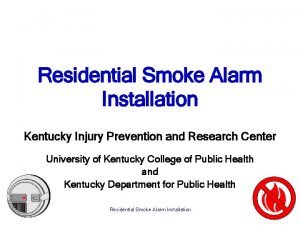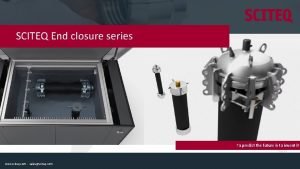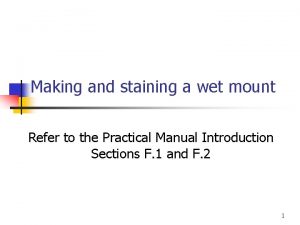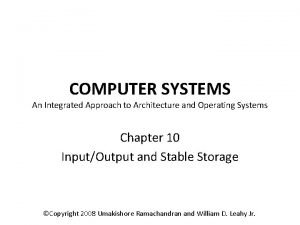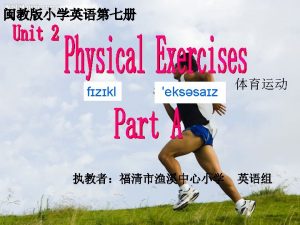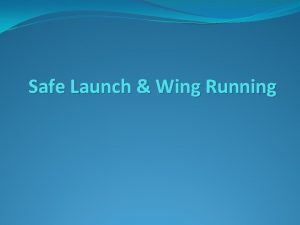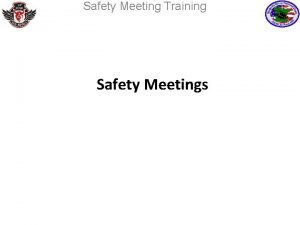SAFETY MEETING RUNNING RIGHT Mounting Dismounting RUNNING RIGHT












- Slides: 12

SAFETY MEETING RUNNING RIGHT

Mounting & Dismounting RUNNING RIGHT

The hazards associated with mounting and dismounting from our work locations are common: this activity represents a real potential for an injury -- every time we perform our work duties! A 43 year-old contractor truck driver with 10 years experience was fatally injured at a lime operation. The victim was found lying on the ground by the rear bulk trailer parked near an access rack. The rack was used to access the hatches on top of the trailer. The victim was hospitalized and died of his injuries on January 22, 2008. Although there were no eyewitnesses, the victim's injuries were consistent with a fall from an elevated location.

RUNNING RIGHT Merely being aware of the hazard is not adequate; each of us must consciously work toward avoiding accidents associated with mounting and dismounting from equipment and stationary work locations. An analysis of mining industry accidents reveals a significant number of mounting /dismounting mishaps.

Most of the injuries associated with this type of accident involve getting on and off mobile equipment and climbing ladders, stairs or other elevated workstations. In most cases, the injuries associated with mounting and dismounting accidents involve slips and falls.

When climbing onto or off equipment both hands should be free of material. Don’t attempt to climb up or down from work locations while carrying supplies, lunch buckets, tools or other items. If it is necessary to have these or other items, hoist them up after mounting or have a co-worker hand them to you. Do not attempt to ascend or descend with anything in your hand.

Using the “three-point contact” rule will eliminate most injuries associated with mounting and dismounting (two hands and one foot or two feet and one hand always in contact with the equipment). This certainly does not mean that we should walk on “threes” while walking up an inclined area. However, when handrails or grab rails are available, utilizing this simple “three-point contact” rule will go a long way toward preventing accidents.

Prior to mounting and dismounting, employees should check their shoes/boots for adequate traction. Footwear should be chosen to afford the maximum amount of traction possible and with consideration for the hazards likely to be encountered on-the-job.

When obstacles are present in the normal route(s) of travel or at workstations, they should be removed. Slipping or tripping hazards in walkways have contributed to a large percentage of the lost time accidents at our operation. Practicing good housekeeping, particularly in relation to walkways, prevents accidents. When walkways are cluttered with supplies, coal or debris, a real possibility of an accident exists.

Remember, use three-point rule when mounting or dismounting from equipment, climbing ladders and ascending or descending inclined walkways or stairs. Look and plan ahead. Observe the walkway a few steps in advance of your location. When obstacles are detected in the walkways --remove them. Your action may prevent an accident. Be alert for other slipping and tripping hazards- (mud, grease, etc. )

Don't jump when getting off equipment. Watch your footing and use the handholds. Always keep safe practices in mind. It is often the little things that cause injuries.

If you can’t afford to do something right, then you can’t afford to do it wrong.
 Once upon a time there was a little man
Once upon a time there was a little man Running running running
Running running running Right product right place right time right price
Right product right place right time right price Family time
Family time Smoke detector mounting tape
Smoke detector mounting tape Dental radiography ppt
Dental radiography ppt End-closure for large diameters
End-closure for large diameters Polyester wall mounting
Polyester wall mounting How to add a stain to a wet mount slide
How to add a stain to a wet mount slide Cpu fan and heatsink mounting points
Cpu fan and heatsink mounting points The right man on the right place at the right time
The right man on the right place at the right time For todays meeting
For todays meeting Meeting objective
Meeting objective




